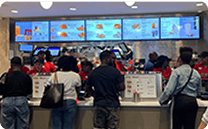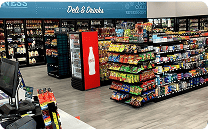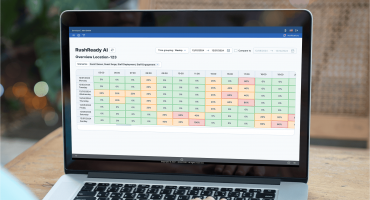In This article
Introduction to Customer Behavior in QSR
You know the QSR business is highly competitive and constantly evolving. You also know that customer experience in QSR environments drives every customer action and decision. To succeed, you must deliver a QSR customer experience that consistently meets or exceeds ever-changing consumer expectations.
Strategies and decisions based on customer behavior data can make your efforts to enhance service quality, optimize menus, and foster customer loyalty more successful and effective. Understanding and tracking customer behavior is your key to creating and delivering experiences your customers enjoy, promote to others, and repeat.
Why Tracking Customer Behavior Matters in QSRs
Monitoring QSR customer behaviors can provide valuable insights into how your customers interact (or don’t) with your store and staff, as well as their purchasing patterns and preferences. You can leverage this knowledge to improve service delivery, heighten customer satisfaction, and increase your operational efficiency. Customer behavior analysis can help you identify trends, anticipate needs, personalize interactions, and enhance the overall QSR customer experience for your customers.
Key Data Points to Track
There are specific elements of customer behavior you must track. You should focus on collecting and analyzing the following data points.
- Demographics: Age, gender, location, and other demographic information can help you segment your customer base and deliver more precisely tailored engagement opportunities.
- Purchase History and Frequency: Understanding what, when, and how often your customers buy provides valuable insights into their preferences, enabling you to identify regular customers and offer opportunities to cultivate and sustain their loyalty.
- Peak Hours and Dwell Time: When your customers visit and how long they stay can help you optimize staffing levels, schedules, and speed of service.
- Preferred Menu Items: Popularity information can help you to fine-tune menu choices and craft more engaging marketing and promotions.
- Digital Interactions: App usage, online order levels, and activity on feedback channels and social media can all help you identify and engage with digital customers more effectively.
- Wait times: Depending on your rush hours, service speed can impact customer wait times and gauge a customer’s willingness to stay in line or head out.
Methods & Tools for Tracking Customer Behavior in QSR
Implementing the right tools is crucial for capturing and analyzing customer behavior:
- Point-of-Sale (POS) Systems: Modern POS systems record transaction data, providing insights into sales patterns and customer preferences.
- Loyalty Programs and Mobile Apps: These platforms track customer engagement, purchase history, and promotion response, facilitating personalized marketing.
- AI-Driven Analytics: Artificial intelligence tools analyze large datasets to identify trends, predict customer behavior, count entries, and recommend actions.
- In-Store Sensors and Heatmaps: These technologies monitor customer movement and dwell time, informing store layout and staffing decisions.
Translating Data into Actionable Insights
It’s insufficient to track, capture, and archive raw customer behavior data. You must analyze that data to convert it into information that drives your strategies and actions. Here are some focus areas to help you deliver a superior QSR customer experience.
- Menu Optimization: Analyze your sales data to identify high-performing and underperforming items and opportunities to align your menu with customer preferences.
- Operational Efficiency: Understand your peak hours and customer flow patterns to improve staff scheduling and resource allocation.
- Personalized Marketing: Use customer data to craft targeted promotions, store layouts, and recommendations that increase engagement and repeat visits.
Leveraging Insights for Better Engagement
Insights into your customer and company data can help create meaningful interactions and enhance the QSR customer experience settings. Here are the steps you can take to gain those insights.
- Targeted Campaigns: Utilize data on customer behaviors, demographic segments, and preferences to enhance the engagement and effectiveness of your marketing initiatives.
- Personalized Recommendations: Use customer purchase history and preferences to enhance the dining experience with specific recommendations and offers.
- Technology Integration: Utilize data on customer interactions with AI-powered chatbots and self-service kiosks to refine your engagement efforts, staff allocations, and other resources.
Best Practices & Privacy Considerations
A comprehensive collection and well-focused analysis of customer behavior and preference data can enable multiple benefits for your customers and your business. However, those collection and analysis efforts must be conducted with the highest possible ethical considerations.
- Transparency: Clearly communicate your data collection practices, provide customer choice and opt-out options, and obtain informed, opt-in consent from customers.
- Privacy Compliance: Comply with regulations that protect personal and proprietary information and consumer privacy, such as the General Data Protection Regulation (GDPR) and the California Consumer Privacy Act (CCPA). Display relevant compliance certifications on signage and online to demonstrate your commitment to protecting your customers’ privacy.
- Data Security: Implement robust security measures to safeguard customer data against breaches, in-store and online. Keep those measures up to date and inform customers about them.
- Balanced Personalization: Ensure your engagement personalization efforts do not become overly intrusive or violate privacy regulations.
Conclusion
Tracking your QSR customer experience and behavior using that data to drive strategic decisions and actions is essential to successful efforts to enhance every customer experience. Leveraging data insights can help you optimize operations, deliver more personalized service, and build more, longer-lasting customer relationships. As the QSR industry continues to evolve, focusing on these strategies and considerations can help you significantly increase satisfaction, loyalty, and business success. To learn how DTiQ helps QSR owners achieve greater success, visit our website.

























